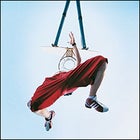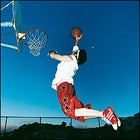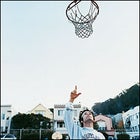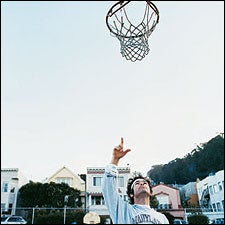THERE’S A PLEASING objectivity about the slam dunk that sets it apart. The rim is ten feet above the ground, and either you can dunk or you can’t. Those hoppy few who can are assumed to be blessed with a gift, a power that isn’t something just anyone with sufficient self-discipline can train for—like, say, running a marathon. Or is it?
Dunk
 GONNA FLY NOW: Writer Josh McHugh drives to the basket.
GONNA FLY NOW: Writer Josh McHugh drives to the basket.Dunk
 HOOP DREAMS: the author takes off
HOOP DREAMS: the author takes offDunk
 MAN ON A MISSION: only four feet to go
MAN ON A MISSION: only four feet to go
At five foot eight and two decades beyond my last participation in organized basketball—in seventh grade—I’m not much of a hoops player. And yet, six months ago, the idea of turning my body into a trim and muscled spring became my obsession. In my primary sports—surfing, snowboarding, and lacrosse—leaping ability isn’t something I necessarily need, but I suspected that adding a few inches to my jump would take my other games to new levels as well.
With a little help from Google, I found an actual dunk coach: Gil “Rise” Thomas, 38, a five-foot-eight jump-training specialist based in Los Angeles. Via his connection with JumpUSA, a Web-based coaching service devoted to increasing athletes’ air time, Thomas has spent the past 15 years helping college and high school basketball and track prodigies leap higher and farther. He told me over the phone that, in six months, his regimen could add 10 to 12 inches to my vertical leap. At the time, I was able to jump 22 inches; by comparison, six-foot, 165-pound Philadelphia 76ers star Allen Iverson can get about 44 inches off the ground.
According to Thomas, the first thing I had to do was slim down. “You’re carrying way too much body fat,” he said after hearing my stats. I weighed 185, and my body-fat percentage was 21.7, which meant I was loaded with more than 40 pounds of blubber. “We need to get you down to 160 and get your fat to under 10 percent. Once you do that, building up your strength to clear 12 more inches of vertical should be easy.”
Thomas prescribed the South Beach Diet and four-day-a-week workouts alternating between weight lifting and jumping drills. The essential gear: a weighted belt for adding 20 pounds to my waist in two-and-a-half-pound increments; a dinner-plate-size wheel with handles on each side, used for building abdominal and hamstring strength; and Jumpsoles, strap-on rubber hooves for my sneakers to force my weight onto the balls of my feet (see “Pre-Flight Checklist,” sidebar).
The weight-lifting program was straightforward: squats, jump squats, modified lunges, and hamstring curls—important, says Thomas, because about 60 percent of a leap’s thrust comes from the hamstrings and glutes.
On the jump-training days, when I donned the Jumpsoles and the weighted belt, I felt like a fourth-grader wearing a slapdash Batman costume on Halloween. The workout consisted of muscling through squats, lunges, and step-ups, followed by a series of 50-yard hopping exercises—first skipping, then hopping like a frog, then alternating legs for two hops at a time. Then came vertical stationary jumps and hill sprints. Each week, I would add more weight to the belt.
Ten weeks into the project, I was lifting more and more weight, but I was stranded three inches short of the rim and jumping rather spastically. I decided I needed to refine my footwork and learn how to explode to the basket. So I contacted Mark Lobl, 45, a San Francisco–based trainer who’s worked with NBA stars Rasheed Wallace and Damon Stoudamire in Nike’s SAQ (speed, agility, and quickness) training program. Lobl’s tools included a speed ladder—basically, a ladder of rope and plastic pipe laid out on the ground, which I stepped through as quickly as possible—and a set of platforms of varying heights to bound up onto. Once I added these plyometric workouts to Thomas’s drills, the upward progress quickly resumed.
Four months into my training, I’d lost 22 pounds, and my body fat was just under 11 percent. My abs were beginning to show—call it a four-pack—for the first time in my life. My chronically weak ankles were stronger, my Achilles tendons and hamstrings felt more supple. On the other hand, my knees hurt constantly—nothing structurally worrisome, just a persistent twinge.
For McHugh’s complete training plan for jumping higher, .
AS I PROGRESSED slowly toward the rim, my powered-up legs took me to a new and giddy level of performance in my other sports. Surfing my local break, San Francisco’s Ocean Beach, became easier thanks to the increased strength in my abs, legs, and back, which allowed me to pop up smoothly, hold a low center of gravity, and crank the board around on cutbacks. In lacrosse games, I was now sprinting, changing directions, and chasing down opponents the way I had in college, more than a decade ago. While snowboarding at Lake Tahoe, I was able to hold screaming toe-side carves through bumps and icy crud that would have sent me sprawling last winter.
Six months to the day after my training started, I could regularly nick the rim with my fingertips, which meant I was jumping 34 inches, and I was ready to show off my new skills. With two dozen (mostly skeptical) friends in attendance at a local gym, I made my bid for dunk-master status. On my first attempt, without holding a ball, I ran at the basket as fast as I could and jumped up. Amazingly, I was able to grab the rim with the palm of my hand and hold on for a split second before I fell to the floor and the basket snapped back into place with a resounding twang. It was the highest I’d ever jumped. Then I tried it with a basketball and clanged it, as they say, again and again—the ball kept slipping out of my sweaty hand as I hoisted it toward the basket. In my quest to dunk, I’d neglected to master half the sequence: the part that involves handling the rock.
In short, I had a long way to go before I could start channeling Allen Iverson. But I’m going to keep training, giving myself three more months to dunk. And even if it doesn’t work out, I’ve gained plenty. Winter swells are still rolling into Ocean Beach, Tahoe is buried under fresh snow, and I’m in the middle of the best season of surfing and snowboarding in my life.


